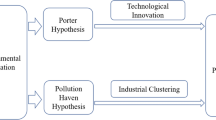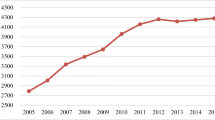Abstract
The objective of this paper is to analyze policy design for air pollution management in the spatial context of urban development. We base our analysis on the paper of Ogawa and Fujita (Reg Sci Urban Econ 12:161–196, 1982), which offers a proper theoretical framework of non-monocentric urban land use using static microeconomic theory where the city structure is endogenous. First, we show that when households internalize industrial pollution in their residential location choice, spatialization within the city is reinforced. This impacts directly the emissions of greenhouse gases from commuting. Then, we analyze policy instruments in order to achieve optimal land use pattern when the policy maker has to manage both industrial and commuting related polluting emissions, that interact through the land market.



Similar content being viewed by others
Notes
The choice of a linear function allows us to compute in a comprehensible manner the following results analytically. Until a given point, similar results can be found using an exponential functional form.
Due to the no cross commuting property, the equilibrium wage profile is a linear function of the distance to the center. Refer to (Ogawa and Fujita 1980) for proofs of these two propositions. They are not altered by the introduction of industrial pollution in the model as the consumption of environmental quality does not enter into the budget constraint and the net income remains the same.
In our case however, with a proper choice of parameters, the rent gradient can remain negative. We adopt this hypothesis for the remaining of the paper in order to keep the analytical results tractable.
The cost of abatement is positive, and increasing and convex with respect to the level of abatement: \(C(a) > 0\), \(C^{\prime }(a)>0\), \(C^{\prime \prime }(a)>0\), for every \(a>a^e\) where \(a^e\) corresponds to the laissez-faire situation.
Since markets are perfectly competitive, firms’ profit is driven to zero at equilibrium, consequently it does not enter the regulator’s program.
We assume in the remainder of the paper that it is sufficiently high to ensure complete compliance.
Their analytical expression is not provided here but is available upon request from the authors.
References
Alonso W (1964) Location and land use: toward a general theory of land rent. Harvard University Press, Cambridge
Arnott R, Hochman O, Rausser GC (2008) Pollution and land use: optimum and decentralization. J Urban Econ 64(2):390–407
Bennear L, Stavins R (2007) Second-best theory and the use of multiple policy instruments. Environ Resour Econ 37(1):111–129
Caplan A (2006) A comparison of emission taxes and permit markets for controlling correlated externalities. Environ Resour Econ 34:471–492
Caplan A, Silva E (2005) An efficient mechanism to control correlated externalities: redistributive transferts and the coexistence of regional and global pollution permit markets. J Environ Econ Manag 49:68–82
Caplan A, Silva E (2007) An equitable, efficient and implementable scheme to control global carbon dioxide emissions. Int Tax Public Finance 14:263–279
Declercq C, Pascal M, Chanel O, Corso M, Ung A, Pascal L, Blanchard M, Larrieu S, Medina S (2012) Impact sanitaire de la pollution atmospherique dans neuf villes françaises: résulats du projet Aphekom, Institut de veille sanitaire, Saint-Maurice
Henderson JV (1977) Externalities in a spatial context: the case of air pollution. J Public Econ 7:89–110
Kyriakopoulou E, Xepapadeas A (2011) Spatial location decision under environmental policy and housing externalities. Environ Econ Policy Stud 13(3):195–217
Kyriakopoulou E, Xepapadeas A (2013) Environmental policy, first nature advantage and the emergence of economic clusters. Reg Sci Urban Econ 43(1):101–116
Legras S (2011) Incomplete model specification in a multi-pollutants setting: the case of climate change and acidification. Resour Energy Econ 33:527–543
McConnell V, Malhon S (1982) Auto pollution and congestion in a urban model: an analysis of alternative strategies. J Urban Econ 11:11–31
Moslener U, Requate T (2007) Optimal abatement in dynamic multi-pollutant problems when pollutants can be complements or substitutes. J Econ Dyn Control 31:2293–2316
Moslener U, Requate T (2009) The dynamics of optimal abatement strategies for multiple pollutants: an illustration in the greenhouse. J Environ Econ Manag 68:1521–1534
Ogawa H, Fujita M (1980) Equilibrium land use patterns in a nonmonocentric city. J Reg Sci 20(4):455–475
Ogawa H, Fujita M (1982) Multiple equilibria and structural transition of non-monocentric urban configurations. Reg Sci Urban Econ 12:161–196
Ren X, Fullerton D, Braden JB (2011) Optimal taxation of externalities interacting through markets: a theoretical general equilibrium analysis. Resour Energy Econ 33:496–514
Richardson H (1977) On the possibility of positive rend gradients. J Urban Econ 4:60–68
Robson AJ (1976) Two models of urban air pollution. J Urban Econ 3:264–284
Schindler M, Caruso G (2014) Urban compactness and the trade-off between air pollution emission and exposure: lessons from a spatially explicit theoretical model. Comput Environ Urban Syst 45:13–23
UNFPA (2007) State of the world population 2007: unleashing the potential of urban growth, United Nation Population Fund, New-York
Verhoef ET, Nijkamp P (2003) Externalities in the urban economy. Tinbergen Institute Discussion Paper No. 03-078/3
Verhoef ET, Nijkamp P (2002) Externalities in urban sustainability: environmental versus localization-type agglomeration externalities in a general spatial equilibrium model of a single-sector monocentric industrial city. Ecol Econ 40(2):157–179
Watkiss P, Pye S, Holland M (2009) Clean air for Europe (CAFE) CBA: baseline analysis 2000 to 2020. Report to the European Commission DG Environment, Brussels
Yang Z (2006) Negatively correlated local and global stock externalities: tax or subsidy? Environ Dev Econ 11:301–316
Acknowledgements
We thank the two anonymous referee and the co-editor for very helpful comments. The research leading to these results has received funding from the European Union by the European Commission within the Seventh Framework Programme in the frame of RURAGRI ERA-NET under Grant Agreement n\(^{\circ }\) 235175 TRUSTEE (ANR-13-RURA-0001-01). The authors only are responsible for any omissions or deficiencies. Neither the TRUSTEE project and any of its partner organizations, nor any organization of the European Union or European Commission are accountable for the content of this research. This research has also receive funding from PUCA (Plan Urbanisme construction architecture).
Author information
Authors and Affiliations
Corresponding author
Appendices
Appendix 1
The density, locational potential and environmental quality functions in the incompletly mixed case are:
-
In the integrated district:
$$\begin{aligned} h(x)= & {} \frac{L_b}{S_b+S_hL_b}, \quad b(x)= \frac{1}{S_b+S_hL_b} \\ E(x)= & {} \bar{E} - e M + \left\{ \frac{\eta }{S_b}\left( f_{2I}^2 - f_{1I}^2\right) + \frac{\eta }{S_b+S_hL_b}\left( f_{1I}^2+x^2\right) \right\} \\ F(x)= & {} \alpha M - \left\{ \frac{\tau }{S_b}\left( f_{2I}^2 - f_{1I}^2\right) + \frac{\tau }{S_b+S_hL_b}\left( f_{1I}^2+x^2\right) \right\} \\ \end{aligned}$$ -
In the business district:
$$\begin{aligned} h(x)= & {} 0 , \quad b(x)=\frac{1}{S_b}\\ E(x)= & {} \bar{E} - e M + \left\{ \frac{\eta }{S_b}\left( f_{2I}^2 - 2f_1x + x^2\right) + \frac{2\eta }{S_b+S_hL_b}f_1x\right\} \\ F(x)= & {} \alpha M - \left\{ \frac{\tau }{S_b}\left( f_{2I}^2 - 2f_{1I}x + x^2\right) + \frac{2\tau }{S_b+S_hL_b}f_{1I}x\right\} \\ \end{aligned}$$ -
In the residential area:
$$\begin{aligned} h(x)= & {} \frac{1}{S_h}, \quad b(x)=0 \\ E(x)= & {} \bar{E} - e M + \left\{ \frac{2\eta }{S_b}\left( f_{2I} - f_{1I}\right) x + \frac{2\eta }{S_b+S_hL_b}f_{1I}x\right\} \\ F(x)= & {} \alpha M - \left\{ \frac{2\tau }{S_b}\left( f_{2I} - f_{1I}\right) x + \frac{2\tau }{S_b+S_hL_b}f_{1I}x\right\} \\ \end{aligned}$$
Appendix 2
As in the case of a completely mixed urban configuration, from (4), (6) and (22a), we obtain the wage profile W(x) in the integrated district. On the residential area, the wage profile is a linear function of distance. To summarize, the wage profile in the city is given by:
Using (4) and the second part of (34), we can compute the value of W(x) at \(f_{1I}\) depending on the level of equilibrium utility \(U^*\). Knowing that this value of \(W(f_{1I})\) must be equal to the value in the first part of (34), we can determine the equilibrium utility level \(U^*\) as a function of \(f_{1I}\) and \(f_{3I}\):
The functional form of F(x) and E(x) allow us to say that F(x) is strictly concave on BD and linear on RA and E(x) is convex on BD and linear on RA. Then, we conclude that R(x) will be concave on BD and linear on RA, so the rest of the land market conditions are equivalent to:
Appendix 3
To compare the aggregate commuting distances in the monocentric and incompletely mixed cases, we plug the definition of \(f_{1M}\), \(f_{2M}\), \(f_{1I}\), \(f_{2I}\) and \(f_{3I}\) in equation (15) and (29):
where \(D_1\) is a second-order equation in t, positive over positive t:
Hence, \(D_M-D_I\) is of the sign of the expression in brackets, which is positive in an incompletly mixed equilibrium.
Appendix 4
In the monocentric case, the regulator maximises SW \(_M=N U^*_M - \gamma _c\) TDC \(_M -\gamma _f\) TDF \(_M\), with respect to a and T, where TDC \(_M=\frac{1}{2}kS_b f_{2M} (f_{2M}-f_{1M})^2\), TDF \(_M= (e-a)M(f_{2M}-f_{1M})-\frac{\eta }{S_b}\left[ \frac{f_{2M}^3}{3} + f_{1M}^2f_{2M}-\frac{4f_{1M}^3}{3}\right] \) and the utility is derived from \(\Psi (f_{2M})=R_a\), from which we can express \(W(0)=S_hR_a+tf_{2M}+U^*-E(f_{2M})-\gamma \ln S_h\); plugging it into \(\Psi (f_{1M})=\Phi (f_{1M})\) we obtain \(U^*_M\) is:
with \(U_1 = \left( \frac{F(f_{1M})-C(a)}{S_b}-\frac{E(f_{1M})+\gamma \ln S_h}{S_h}\right) \).
In the completely mixed case, setting \(\Psi (f_{1C})=\Phi (f_{1C})=R_a\) we obtain:
Furthermore, TDC \(_C=0\) and TDC \(_F=(e-a)Mf_{1C}-\frac{4}{3}\frac{\eta }{S_hL_b+S_b} f_{1C}^3\).
In the incompletely mixed case, the regulator maximises \(SW_I=\) NU \(^*_I - \gamma _c\) TDC \(_I -\gamma _f\) TDF \(_I\) with respect to T and a. The utility level and the new wage profile are determined in Appendix 2. The damage terms are: TDC \(_I = k D_I(T) = k\cdot \frac{1}{2} S_b (f_{3I}-f_{1I}) (f_{3I}-f_{2I})^2\) and TDF \(_I = \int _X\int _Y [e - \eta |x-y|]b(y)dydx \):
Rights and permissions
About this article
Cite this article
Regnier, C., Legras, S. Urban Structure and Environmental Externalities. Environ Resource Econ 70, 31–52 (2018). https://doi.org/10.1007/s10640-016-0109-0
Accepted:
Published:
Issue Date:
DOI: https://doi.org/10.1007/s10640-016-0109-0




